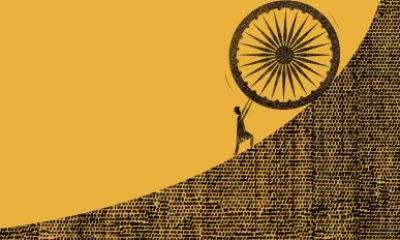
|
Getting your Trinity Audio player ready...
|
(The article was originally published in Indian Express on November 15, 2025 as a part of Dr Madhav’s column titled ‘Ram Rajya’. Views expressed are personal.)
We need to find a new vocabulary to describe the near-sweep of the BJP and its allies JD (U) and LJSP in Bihar assembly elections. This result once again established the complete domination and near invincibility of the saffron party in the Hindi heartland. A couple of exceptions notwithstanding, in a normal electoral combat like the one witnessed in Bihar, it is impossible to defeat it.
To understand the results, one needs to understand the winning formula that the party leadership stitches up and diligently implements in every election. Unlike the other parties, for the BJP leadership, politics is a 24/7 activity. The party takes every electoral battle seriously and approaches it with a killer instinct. Keeping the political machinery of the party well-oiled and active all the time is an important element of BJP’s electoral strategy. Contrast it with the opposition. Rahul Gandhi acquired notoriety for abstention from the political scene more than active participation. In Bihar, he launched an aggressive campaign of the so-called “vote-chori” a couple of months ago, but suddenly disappeared from the scene for several weeks after that. Media reported that he was somewhere in Latin America complaining about Indian electoral system to students in some obscure universities.
The BJP’s winning formula includes focus on prime minister Narendra Modi’s popularity and successful governance. In Bihar election campaign, Modi addressed huge rallies at 14 places covering key districts. Data showed that areas where he campaigned witnessed higher voter turnout besides injecting greater enthusiasm in the cadre and supporters. Modi began his election campaign on October 24 from Samastipur, the ancestral village of Karpoori Thakur, a highly respected former chief minister whom the Modi government had honoured with Bharat Ratna award. Symbolic the gesture may be, it did send a strong message across the state that the NDA was committed to providing a clean, honest, marginalised-people-friendly and effective government, qualities generally attributed to Karpoori Thakur. Samastipur saw 71.74 percent voter turnout, while other constituencies like Begusarai and Muzaffarpur, which also saw prime minister’s extensive campaign, experienced higher turnouts of 69.87 and 71.81 percent respectively.
BJP’s ability to identify right mix of appropriate electoral issues and creating a powerful messaging mechanism to disseminate them is another element of its strength. Union government’s welfare programs that became a big help for women, elderly and underprivileged in the last decade led to ordinary people developing trust in Modi’s governance. From Samastipur, by paying tributes to Jan Nayak Karpoori Thakur, Modi used that image to set the tone for the electoral battle as one between good governance and ‘jungle raj’. Threat of the return of ‘Jungle Raj’, which became synonymous with the erstwhile regime of Lalu Prasad Yadav, in a way, became the singular electoral theme in this election. While those who witnessed Lalu years remembered the dreadful times, for the millennials and other young voters, fear of the return of lawlessness became a dominant electoral theme.
The opposition looked helpless in countering this shrewd and sharp BJP attack. Tejasvi Yadav, despite efforts to carve a different image for himself in the last five years, could not come out of the shadow of his father. His campaign too did not help give the impression to the voters that the RJD could provide decent governance. If anything, the loudmouth and arrogant spokespersons – a couple of women in particular – representing his party further fortified the image of an uncouth and unruly party. While the BJP’s good governance agenda was effectively presented to the voters through extensive campaigning by several chief ministers and central ministers, Tejasvi was left to campaign alone with nobody from the opposition wholeheartedly coming forward to counter BJP’s focused attack of Jungle Raj.
The BJP’s organisational strength is another major weapon that no other party can combat. Home Minister Amit Shah, expert in electoral management, camped in the state for several weeks and stitched together an intense and organised campaign across all the 243 assembly segments in the state. More than 900 senior leaders from across the country, deputed to Bihar for two months to manage the campaign at the grassroot level, kept the local party machinery active and ensured that each and every household is reached out. In addition, the party enjoys the advantage of the support of the Sangh Parivar too.
As far as the alliances are concerned, as always, Congress remained an albatross around RJD’s neck. It demanded and took more than 60 seats and ended up winning less than 10 percent of them. On the other hand, JD(U), BJP’s ally led by Nitish Kumar, played a majorly complimentary role in achieving this historic mandate. Nitish enjoys good image among a section of the electorate in the state. If re-elected this time, he will be entering 10th term as CM. He created history by being the CM for more than 20 years now. This victory established Modi’s credentials as an able alliance manager once again.
But the most important message from this election result was the end of caste politics in Bihar. Bereft of any credible agenda, Tejasvi kept his hopes solely on the rotten MY formula. The fact that he himself trailed for several rounds in the family stronghold of Raghopur, besides the dismal performance of his party, showed that the voters opted for good governance over caste loyalty. That is the good news which will change Bihar’s destiny in coming years.




